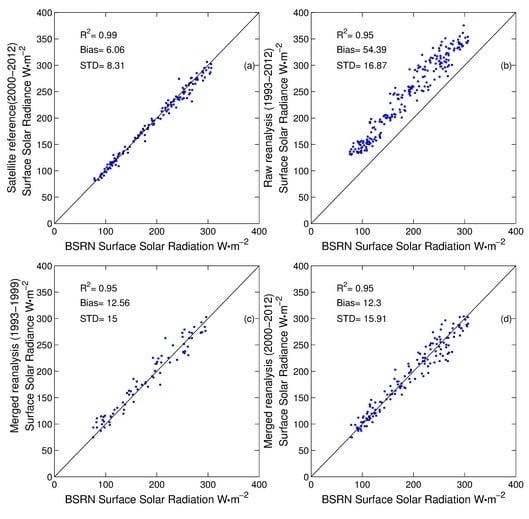Merging Satellite Retrievals and Reanalyses to Produce Global Long-Term and Consistent Surface Incident Solar Radiation Datasets
Abstract
:1. Introduction
2. Materials and Methods
2.1. Ground Observations of Surface Solar Radiation
2.2. Satellite Surface Solar Radiation Retrievals
2.3. Reanalysis
2.4. Method
3. Results
3.1. Comparisons of the Reanalyses and CERES EBAF Surface Product
3.2. Evaluation of the Merged Surface Solar Radiation Data
3.3. Seasonal Variations in Rs
3.4. Annual Variations in Rs
4. Discussion
4.1. Different Performance of Reanalyses
4.2. Comparison with Other Fusion Methods
4.3. Advantages and Uncertainties
5. Conclusions
Acknowledgments
Author Contributions
Conflicts of Interest
References
- Wang, K.; Dickinson, R.E.; Wild, M.; Liang, S. Evidence for decadal variation in global terrestrial evapotranspiration between 1982 and 2002: 1. Model development. J. Geophys. Res. Atmos. 2010, 115. [Google Scholar] [CrossRef]
- Roderick, M.L.; Rotstayn, L.D.; Farquhar, G.D.; Hobbins, M.T. On the attribution of changing pan evaporation. Geophys. Res. Lett. 2007, 34, 251–270. [Google Scholar] [CrossRef]
- Mahmood, R.; Hubbard, K.G. Assessing bias in evapotranspiration and soil moisture estimates due to the use of modeled solar radiation and dew point temperature data. Agric. For. Meteorol. 2005, 130, 71–84. [Google Scholar] [CrossRef]
- Yang, X.; Tang, J.; Mustard, J.F.; Lee, J.E.; Rossini, M.; Joiner, J.; Munger, J.W.; Kornfeld, A.; Richardson, A.D. Solar-induced chlorophyll fluorescence that correlates with canopy photosynthesis on diurnal and seasonal scales in a temperate deciduous forest. Geophys. Res. Lett. 2015, 42, 2977–2987. [Google Scholar] [CrossRef]
- Zhao, M.; Running, S.W. Drought-induced reduction in global terrestrial net primary production from 2000 through 2009. Science 2010, 329, 940–943. [Google Scholar] [CrossRef] [PubMed]
- Piao, S.; Fang, J.; He, J. Variations in vegetation net primary production in the qinghai-xizang plateau, china, from 1982 to 1999. Clim. Chang. 2006, 74, 253–267. [Google Scholar] [CrossRef]
- Kim, Y.-U.; Lee, B.-W. Effect of high temperature, daylength, and reduced solar radiation on potato growth and yield. Korean J. Agric. For. Meteorol. 2016, 18, 74–87. [Google Scholar] [CrossRef]
- Wild, M.; Gilgen, H.; Roesch, A.; Ohmura, A.; Long, C.N.; Dutton, E.G.; Forgan, B.; Kallis, A.; Russak, V.; Tsvetkov, A. From dimming to brightening: Decadal changes in solar radiation at earth's surface. Science 2005, 308, 847–850. [Google Scholar] [CrossRef] [PubMed]
- Wild, M. Global dimming and brightening: A review. J. Geophys. Res. Atmos. 2009, 114. [Google Scholar] [CrossRef]
- Wang, K.; Ma, Q.; Li, Z.; Wang, J. Decadal variability of surface incident solar radiation over China: Observations, satellite retrievals, and reanalyses. J. Geophys. Res. Atmos. 2015, 120, 6500–6514. [Google Scholar] [CrossRef]
- Wang, K. Measurement biases explain discrepancies between the observed and simulated decadal variability of surface incident solar radiation. Sci. Rep. 2014, 4. [Google Scholar] [CrossRef] [PubMed]
- Ma, Q.; Wang, K.; Wild, M. Impact of geolocations of validation data on the evaluation of surface incident shortwave radiation from earth system models. J. Geophys. Res. Atmos. 2015, 120, 6825–6844. [Google Scholar] [CrossRef]
- Wang, K.; Augustine, J.; Dickinson, R.E. Critical assessment of surface incident solar radiation observations collected by surfrad, uscrn and ameriflux networks from 1995 to 2011. J. Geophys. Res. Atmos. 2012, 117. [Google Scholar] [CrossRef]
- Ohmura, A.; Gilgen, H.; Hegner, H.; Müller, G.; Wild, M.; Dutton, E.G.; Forgan, B.; Fröhlich, C.; Philipona, R.; Heimo, A. Baseline surface radiation network (bsrn/wcrp): New precision radiometry for climate research. Bull. Am. Meteorol. Soc. 1998, 79, 2115–2136. [Google Scholar] [CrossRef]
- Long, C.N.; Dutton, E.G.; Augustine, J.; Wiscombe, W.; Wild, M.; McFarlane, S.A.; Flynn, C.J. Significant decadal brightening of downwelling shortwave in the continental united states. J. Geophys. Res. Atmos. 2009, 114, 1291–1298. [Google Scholar] [CrossRef]
- Dolinar, E.K.; Dong, X.; Xi, B. Evaluation and intercomparison of clouds, precipitation, and radiation budgets in recent reanalyses using satellite-surface observations. Clim. Dyn. 2016, 46, 2123–2144. [Google Scholar] [CrossRef]
- Zib, B.J.; Dong, X.; Xi, B.; Kennedy, A. Evaluation and intercomparison of cloud fraction and radiative fluxes in recent reanalyses over the arctic using bsrn surface observations. J. Clim. 2012, 25, 2291–2305. [Google Scholar] [CrossRef]
- Augustine, J.A.; DeLuisi, J.J.; Long, C.N. Surfrad—A national surface radiation budget network for atmospheric research. Bull. Am. Meteorol. Soc. 2000, 81, 2341–2357. [Google Scholar] [CrossRef]
- Yang, K.; Koike, T.; Ye, B. Improving estimation of hourly, daily, and monthly solar radiation by importing global data sets. Agric. For. Meteorol. 2006, 137, 43–55. [Google Scholar] [CrossRef]
- Sanchezlorenzo, A.; Calbó, J.; Brunetti, M.; Deser, C. Dimming/brightening over the iberian peninsula: Trends in sunshine duration and cloud cover and their relations with atmospheric circulation. J. Geophys. Res. Atmos. 2009, 114, 195–200. [Google Scholar]
- Wang, K.C.; Dickinson, R.E.; Wild, M.; Liang, S. Atmospheric impacts on climatic variability of surface incident solar radiation. Atmos. Chem. Phys. 2012, 12, 9581–9592. [Google Scholar] [CrossRef] [Green Version]
- Sanchezlorenzo, A.; Wild, M. Decadal variations in estimated surface solar radiation over switzerland since the late 19th century. Atmos. Chem. Phys. 2012, 12, 8635–8644. [Google Scholar] [CrossRef] [Green Version]
- Sanchezromero, A.; Sanchezlorenzo, A.; Calbó, J.; González, J.A.; Azorin-Molina, C. The signal of aerosol-induced changes in sunshine duration records: A review of the evidence. J. Geophys. Res. Atmos. 2014, 119, 4657–4673. [Google Scholar] [CrossRef]
- Sanchezlorenzo, A.; Calbó, J.; Martinvide, J. Spatial and temporal trends in sunshine duration over western europe (1938-2004). J. Clim. 2008, 21, 6089–6098. [Google Scholar] [CrossRef]
- Tang, W.J.; Yang, K.; Qin, J.; Cheng, C.C.K.; He, J. Solar radiation trend across china in recent decades: A revisit with quality-controlled data. Atmos. Chem. Phys. 2011, 11, 393–406. [Google Scholar] [CrossRef]
- Pinker, R.; Laszlo, I. Modeling surface solar irradiance for satellite applications on a global scale. J. Appl. Meteorol. 1992, 31, 194–211. [Google Scholar] [CrossRef]
- Rossow, W.B.; Schiffer, R.A. Advances in understanding clouds from isccp. Bull. Am. Meteorol. Soc. 1999, 80, 2261–2287. [Google Scholar] [CrossRef]
- Stubenrauch, C.; Rossow, W.; Kinne, S.; Ackerman, S.; Cesana, G.; Chepfer, H.; Di Girolamo, L.; Getzewich, B.; Guignard, A.; Heidinger, A. Assessment of global cloud datasets from satellites: Project and database initiated by the gewex radiation panel. Bull. Am. Meteorol. Soc. 2013, 94, 1031–1049. [Google Scholar] [CrossRef]
- Evan, A.T.; Heidinger, A.K.; Vimont, D.J. Arguments against a physical long-term trend in global isccp cloud amounts. Geophys. Res. Lett. 2007, 34, 290–303. [Google Scholar] [CrossRef]
- Dai, A.; Karl, T.R.; Sun, B.; Trenberth, K.E. Recent trends in cloudiness over the united states: A tale of monitoring inadequacies. Bull. Am. Meteorol. Soc. 2006, 87, 597–606. [Google Scholar] [CrossRef]
- Doelling, D.R.; Loeb, N.G.; Keyes, D.F.; Nordeen, M.L.; Morstad, D.; Nguyen, C.; Wielicki, B.A.; Young, D.F.; Sun, M. Geostationary enhanced temporal interpolation for ceres flux products. J. Atmos. Ocean. Technol. 2013, 30, 1072–1090. [Google Scholar] [CrossRef]
- Zhang, X.; Liang, S.; Wild, M.; Jiang, B. Analysis of surface incident shortwave radiation from four satellite products. Remote Sens. Environ. 2015, 165, 186–202. [Google Scholar] [CrossRef]
- Slater, A.G. Surface solar radiation in north america: A comparison of observations, reanalyses, satellite, and derived products. J. Hydrometeorol. 2016, 17, 401–420. [Google Scholar] [CrossRef]
- Kim, C.K.; Holmgren, W.F.; Stovern, M.; Betterton, E.A. Toward improved solar irradiance forecasts: Comparison of downwelling surface shortwave radiation in arizona derived from satellite with the gridded datasets. Pure Appl. Geophys. 2016, 173, 2929–2943. [Google Scholar] [CrossRef]
- Boilley, A.; Wald, L. Comparison between meteorological re-analyses from era-interim and merra and measurements of daily solar irradiation at surface. Renew. Energy 2015, 75, 135–143. [Google Scholar] [CrossRef] [Green Version]
- Zhang, X.; Liang, S.; Wang, G.; Yao, Y.; Jiang, B.; Cheng, J. Evaluation of the reanalysis surface incident shortwave radiation products from ncep, ecmwf, gsfc, and jma using satellite and surface observations. Remote Sens. 2016, 8, 225. [Google Scholar] [CrossRef]
- Jia, B.; Xie, Z.; Dai, A.; Shi, C.; Chen, F. Evaluation of satellite and reanalysis products of downward surface solar radiation over east asia: Spatial and seasonal variations. J. Geophys. Res. Atmos. 2013, 118, 3431–3446. [Google Scholar] [CrossRef]
- Wang, K.; Dickinson, R.E.; Ma, Q.; Augustine, J.A.; Wild, M. Measurement methods affect the observed global dimming and brightening. J. Clim. 2013, 26, 4112–4120. [Google Scholar] [CrossRef]
- Driemel, A.; Koenig-Langlo, G.; Long, C. Bsrn Station Requirements Overview, Status 20170401. Available online: http://epic.awi.de/44345/ (accessed on 11 November 2017).
- Roesch, A.; Wild, M.; Ohmura, A.; Dutton, E.G.; Long, C.N.; Zhang, T. Assessment of bsrn radiation records for the computation of monthly means. Atmos. Meas. Tech. 2011, 4, 339–354. [Google Scholar] [CrossRef] [Green Version]
- Winker, D.; Pelon, J.; Coakley Jr, J.; Ackerman, S.; Charlson, R.; Colarco, P.; Flamant, P.; Fu, Q.; Hoff, R.; Kittaka, C. The calipso mission: A global 3d view of aerosols and clouds. Bull. Am. Meteorol. Soc. 2010, 91, 1211–1229. [Google Scholar] [CrossRef]
- Kato, S.; Loeb, N.G.; Rose, F.G.; Doelling, D.R.; Rutan, D.A.; Caldwell, T.E.; Yu, L.; Weller, R.A. Surface irradiances consistent with ceres-derived top-of-atmosphere shortwave and longwave irradiances. J. Clim. 2013, 26, 2719–2740. [Google Scholar] [CrossRef]
- Dee, D.; Uppala, S.; Simmons, A.; Berrisford, P.; Poli, P.; Kobayashi, S.; Andrae, U.; Balmaseda, M.; Balsamo, G.; Bauer, P. The era-interim reanalysis: Configuration and performance of the data assimilation system. Q. J. R. Meteorol. Soc. 2011, 137, 553–597. [Google Scholar] [CrossRef]
- Molod, A.; Takacs, L.; Suarez, M.; Bacmeister, J. Development of the geos-5 atmospheric general circulation model: Evolution from merra to merra2. Geosci. Model Dev. 2015, 8, 1339–1356. [Google Scholar] [CrossRef]
- Saha, S.; Moorthi, S.; Pan, H.-L.; Wu, X.; Wang, J.; Nadiga, S.; Tripp, P.; Kistler, R.; Woollen, J.; Behringer, D. The ncep climate forecast system reanalysis. Bull. Am. Meteorol. Soc. 2010, 91, 1015–1057. [Google Scholar] [CrossRef]
- Kobayashi, S.; Yukinari, O.; Harada, Y.; Ebita, A.; Moriya, M.; Onoda, H.; Onogi, K.; Kamahori, H.; Kobayashi, C.; MIYAOKA, K. The jra-55 reanalysis: General specifications and basic characteristics. J. Meteorol. Soc. Jpn. 2015, 93, 5–48. [Google Scholar] [CrossRef]
- Kanamitsu, M.; Ebisuzaki, W.; Woollen, J.; Yang, S.-K.; Hnilo, J.; Fiorino, M.; Potter, G. Ncep–doe amip-ii reanalysis (r-2). Bull. Am. Meteorol. Soc. 2002, 83, 1631–1643. [Google Scholar] [CrossRef]
- Kalnay, E.; Kanamitsu, M.; Kistler, R.; Collins, W.; Deaven, D.; Gandin, L.; Iredell, M.; Saha, S.; White, G.; Woollen, J. The ncep/ncar 40-year reanalysis project. Bull. Am. Meteorol. Soc. 1996, 77, 437–471. [Google Scholar] [CrossRef]
- Hersbach, H.; Peubey, C.; Simmons, A.; Berrisford, P.; Poli, P.; Dee, D. Era-20cm: A twentieth-century atmospheric model ensemble. Q. J. R. Meteorol. Soc. 2015, 141, 2350–2375. [Google Scholar] [CrossRef]
- Compo, G.P.; Whitaker, J.S.; Sardeshmukh, P.D.; Matsui, N.; Allan, R.J.; Yin, X.; Gleason, B.E.; Vose, R.S.; Rutledge, G.; Bessemoulin, P. The twentieth century reanalysis project. Q. J. R. Meteorol. Soc. 2011, 137, 1–28. [Google Scholar] [CrossRef]
- Oreopoulos, L.; Mlawer, E. Modeling: The continual intercomparison of radiation codes (circ) assessing anew the quality of gcm radiation algorithms. Bull. Am. Meteorol. Soc. 2010, 91, 305–310. [Google Scholar] [CrossRef]
- Randles, C.; da Silva, A.; Buchard, V.; Colarco, P.; Darmenov, A.; Govindaraju, R.; Smirnov, A.; Holben, B.; Ferrare, R.; Hair, J. The merra-2 aerosol reanalysis, 1980–onward, part i: System description and data assimilation evaluation. J. Clim. 2017, 21, 6089–6098. [Google Scholar] [CrossRef]
- Xie, P.; Xiong, A.Y. A conceptual model for constructing high-resolution gauge-satellite merged precipitation analyses. J. Geophys. Res. Atmos. 2011, 116. [Google Scholar] [CrossRef]
- Shimpo, A.; Kanamitsu, M.; Iacobellis, S.F.; Hong, S.-Y. Comparison of four cloud schemes in simulating the seasonal mean field forced by the observed sea surface temperature. Mon. Weather Rev. 2008, 136, 2557–2575. [Google Scholar] [CrossRef]
- Mapes, B.E.; Warner, T.T.; Xu, M.; Gochis, D.J. Comparison of cumulus parameterizations and entrainment using domain-mean wind divergence in a regional model. J. Atmos. Sci. 2004, 61, 1284–1295. [Google Scholar] [CrossRef]
- Xia, X.A.; Wang, P.C.; Chen, H.B.; Liang, F. Analysis of downwelling surface solar radiation in china from national centers for environmental prediction reanalysis, satellite estimates, and surface observations. J. Geophys. Res. Atmos. 2006, 111, 2105–2117. [Google Scholar] [CrossRef]
- Li, Z. Intercomparison between two satellite-based products of net surface shortwave radiation. J. Geophys. Res. Atmos. 1995, 100, 3221–3232. [Google Scholar] [CrossRef]
- Li, J.; Carlson, B.E.; Dubovik, O.; Lacis, A.A. Recent trends in aerosol optical properties derived from aeronet measurements. Atmos. Chem. Phys. 2014, 14, 12271–12289. [Google Scholar] [CrossRef]
- Che, H.Z.; Shi, G.Y.; Zhang, X.Y.; Arimoto, R.; Zhao, J.Q.; Xu, L.; Wang, B.; Chen, Z.H. Analysis of 40 years of solar radiation data from china, 1961–2000. Geophys. Res. Lett. 2005, 1029, 2341–2352. [Google Scholar] [CrossRef]
- Journée, M.; Bertrand, C. Improving the spatio-temporal distribution of surface solar radiation data by merging ground and satellite measurements. Remote Sens. Environ. 2010, 114, 2692–2704. [Google Scholar] [CrossRef]
- Polo, J.; Wilbert, S.; Ruiz-Arias, J.; Meyer, R.; Gueymard, C.; Suri, M.; Martin, L.; Mieslinger, T.; Blanc, P.; Grant, I.; et al. Integration of Ground Measurements to Model-Derived Data: A Report of IEA SHC Task 46 Solar Resource assessment and Forecasting; International Energy Agency: Paris, France, 2015. [Google Scholar]
- Polo, J.; Wilbert, S.; Ruiz-Arias, J.A.; Meyer, R.; Gueymard, C.; Suri, M.; Martín, L.; Mieslinger, T.; Blanc, P.; Grant, I. Preliminary survey on site-adaptation techniques for satellite-derived and reanalysis solar radiation datasets. Sol. Energy 2016, 132, 25–37. [Google Scholar] [CrossRef]
- Mieslinger, T.; Ament, F.; Chhatbar, K.; Meyer, R. A new method for fusion of measured and model-derived solar radiation time-series. Energy Procedia 2014, 48, 1617–1626. [Google Scholar] [CrossRef]
- Pitkänen, M.R.; Mikkonen, S.; Lehtinen, K.E.; Lipponen, A.; Arola, A. Artificial bias typically neglected in comparisons of uncertain atmospheric data. Geophys. Res. Lett. 2016, 43, 10003–10011. [Google Scholar] [CrossRef]
- Erickson, M.J.; Colle, B.A.; Charney, J.J. Impact of bias-correction type and conditional training on bayesian model averaging over the northeast united states. Weather Forecast. 2012, 27, 1449–1469. [Google Scholar] [CrossRef]
- Hamill, T.M. Comments on “calibrated surface temperature forecasts from the canadian ensemble prediction system using bayesian model averaging”. Mon. Weather Rev. 2007, 135, 4226–4230. [Google Scholar] [CrossRef]
- Alvarez-Garreton, C.; Ryu, D.; Western, A.; Crow, W.; Robertson, D. The impacts of assimilating satellite soil moisture into a rainfall–runoff model in a semi-arid catchment. J. Hydrol. 2014, 519, 2763–2774. [Google Scholar] [CrossRef]
- Zhao, L.; Lee, X.; Liu, S. Correcting surface solar radiation of two data assimilation systems against fluxnet observations in north america. J. Geophys. Res. Atmos. 2013, 118, 9552–9564. [Google Scholar] [CrossRef]
- Hakuba, M.Z.; Folini, D.; Sanchezlorenzo, A.; Wild, M. Spatial representativeness of ground-based solar radiation measurements. J. Geophys. Res. Atmos. 2013, 118, 8585–8597. [Google Scholar] [CrossRef]
- Huang, G.; Li, X.; Huang, C.; Liu, S.; Ma, Y.; Chen, H. Representativeness errors of point-scale ground-based solar radiation measurements in the validation of remote sensing products. Remote Sens. Environ. 2016, 181, 198–206. [Google Scholar] [CrossRef]
- Li, Z.; Cribb, M.; Chang, F.L.; Trishchenko, A.; Luo, Y. Natural variability and sampling errors in solar radiation measurements for model validation over the atmospheric radiation measurement southern great plains region. J. Geophys. Res. Atmos. 2005, 110. [Google Scholar] [CrossRef]
- Lindsay, R.; Wensnahan, M.; Schweiger, A.; Zhang, J. Evaluation of seven different atmospheric reanalysis products in the arctic*. J. Clim. 2014, 27, 2588–2606. [Google Scholar] [CrossRef]
- Wang, A.; Zeng, X. Evaluation of multireanalysis products with in situ observations over the tibetan plateau. J. Geophys. Res. Atmos. 2012, 117. [Google Scholar] [CrossRef]
- Decker, M.; Brunke, M.A.; Wang, Z.; Sakaguchi, K.; Zeng, X.; Bosilovich, M.G. Evaluation of the reanalysis products from gsfc, ncep, and ecmwf using flux tower observations. J. Clim. 2012, 25, 1916–1944. [Google Scholar] [CrossRef]
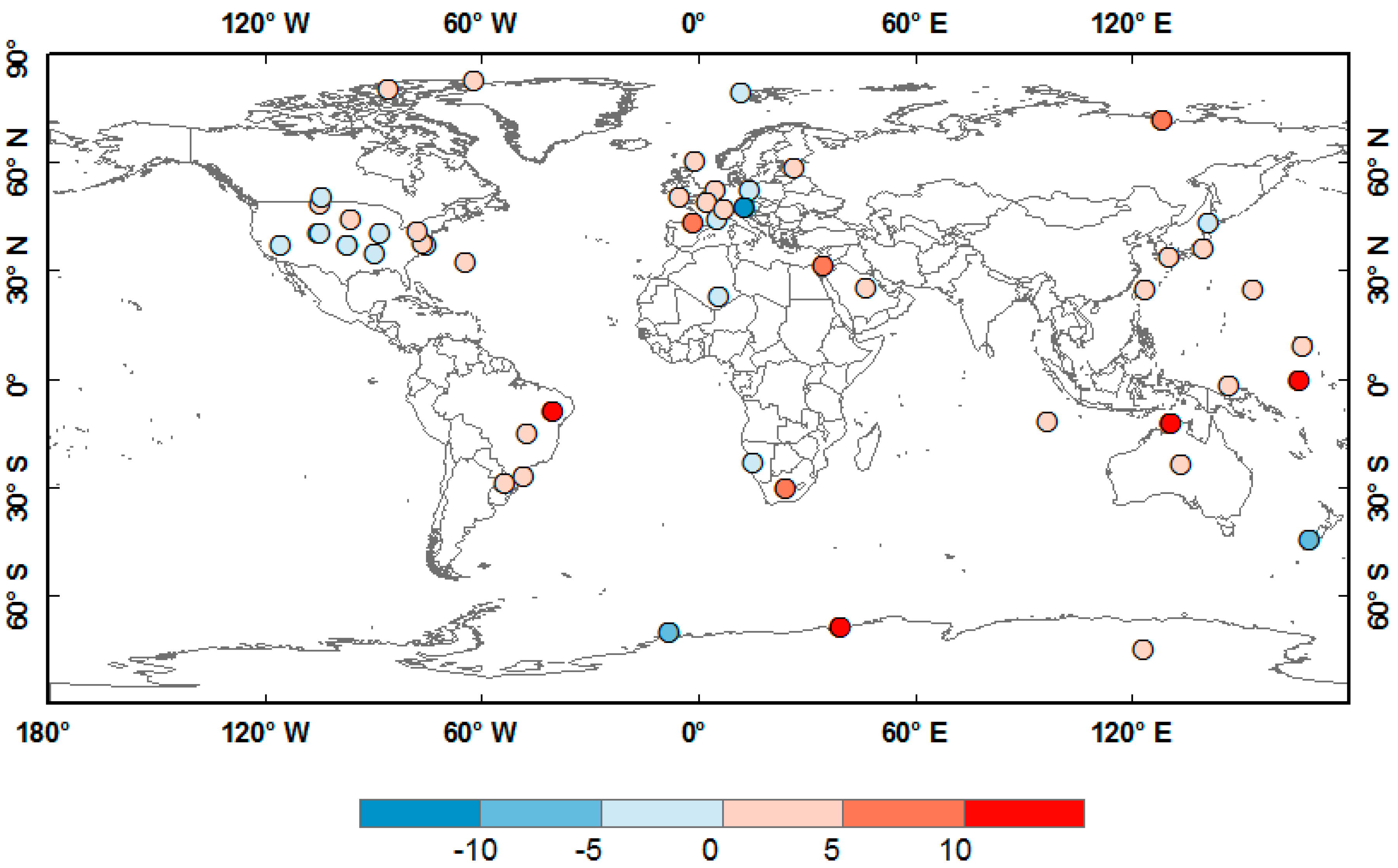

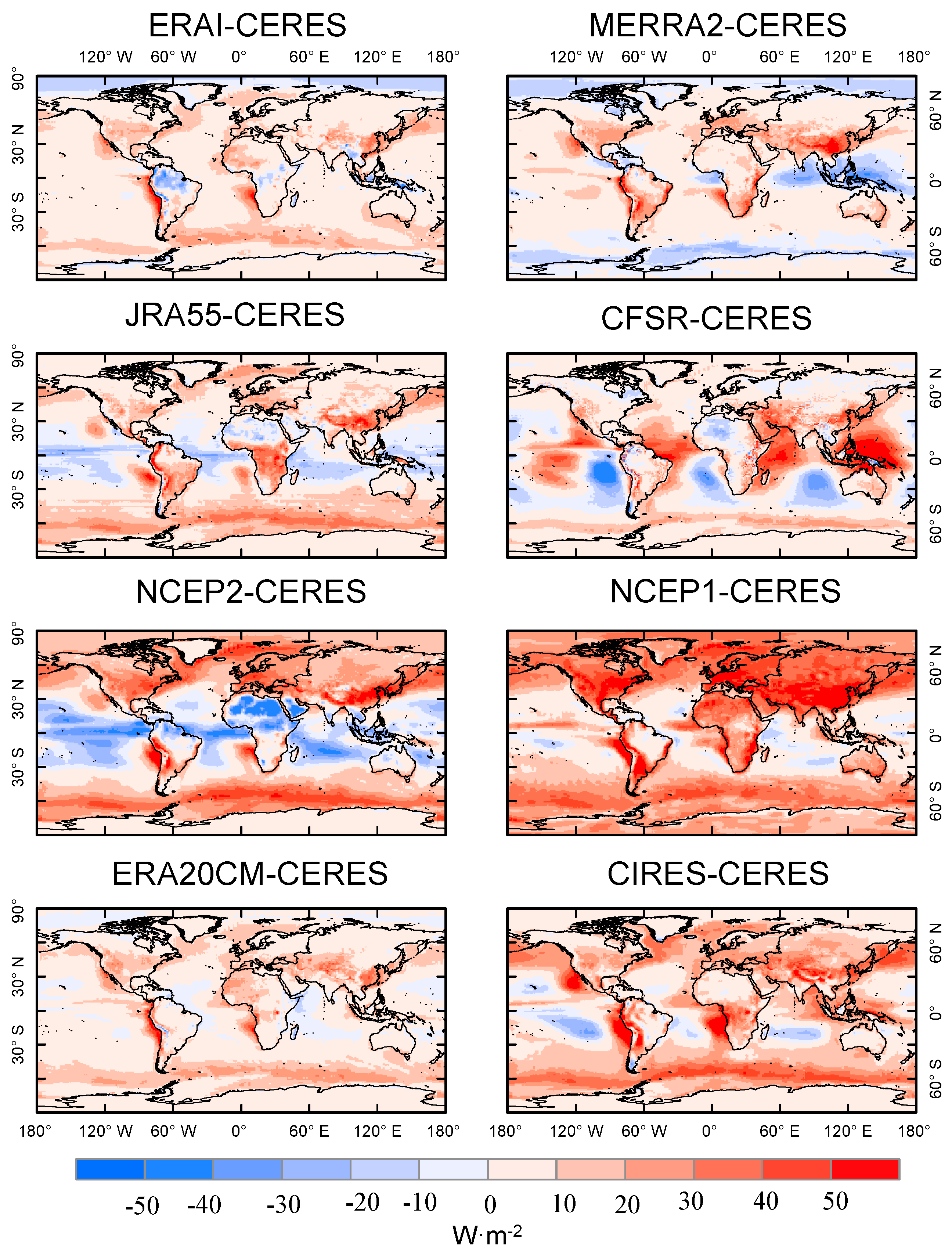
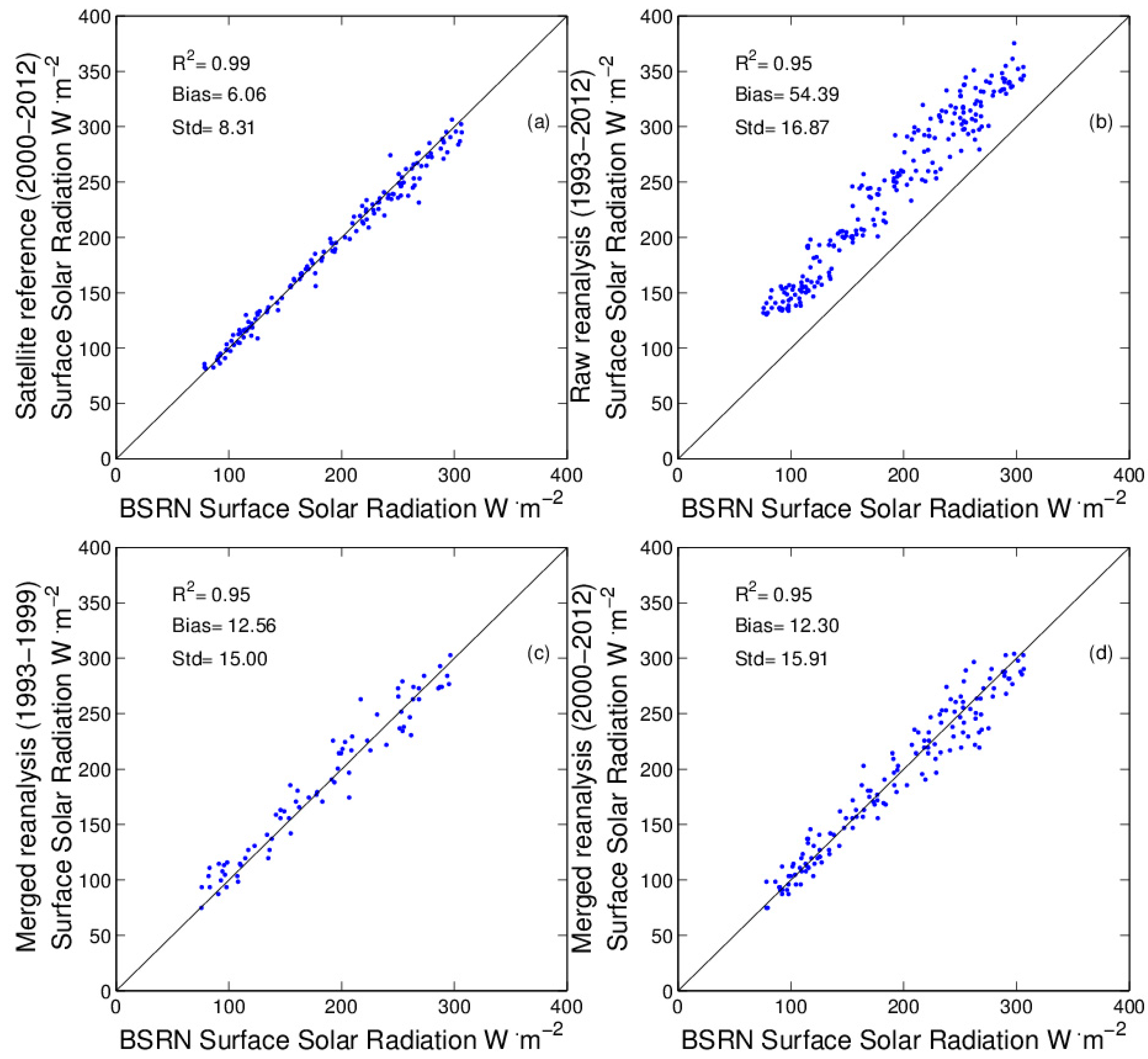

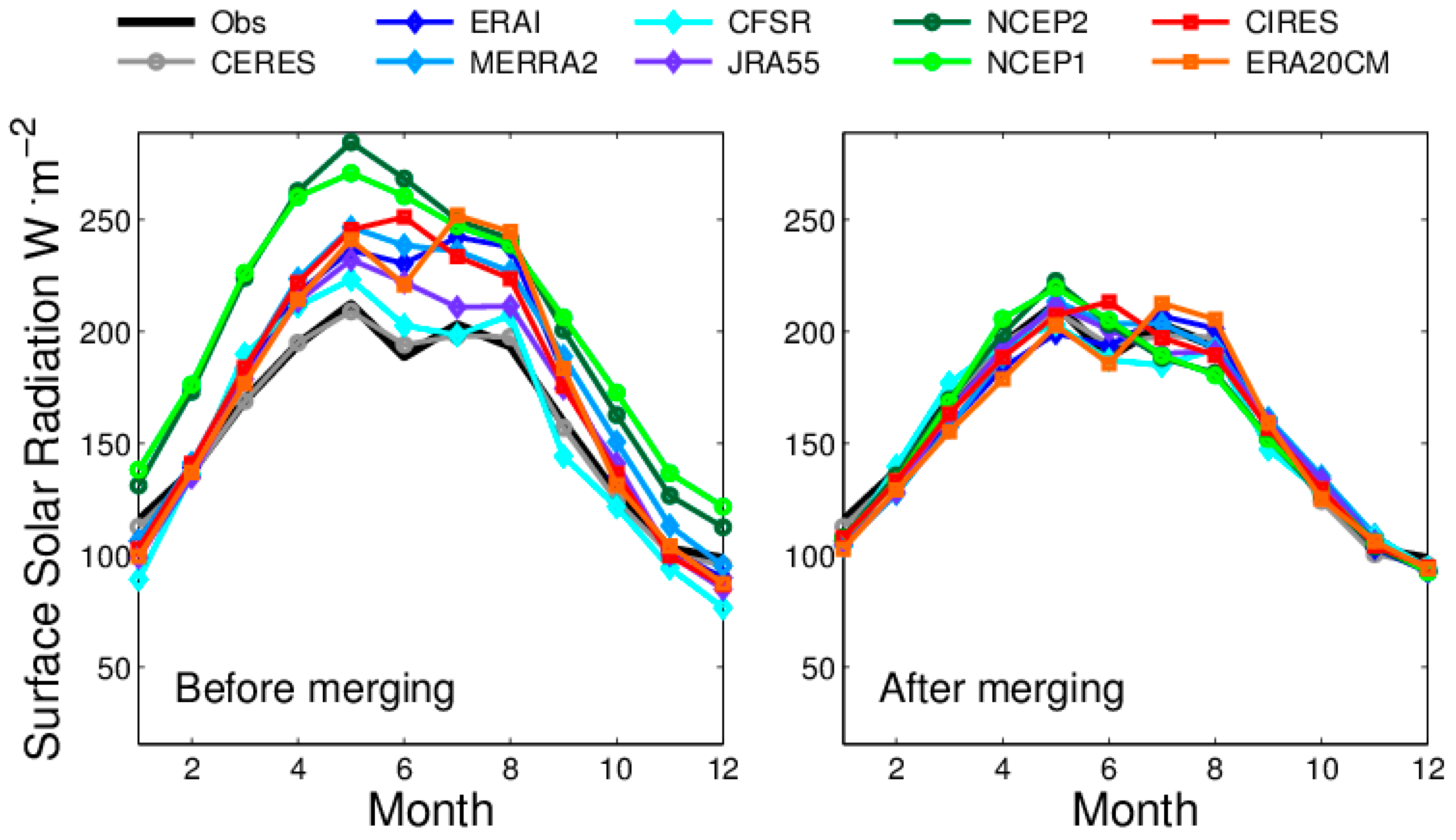
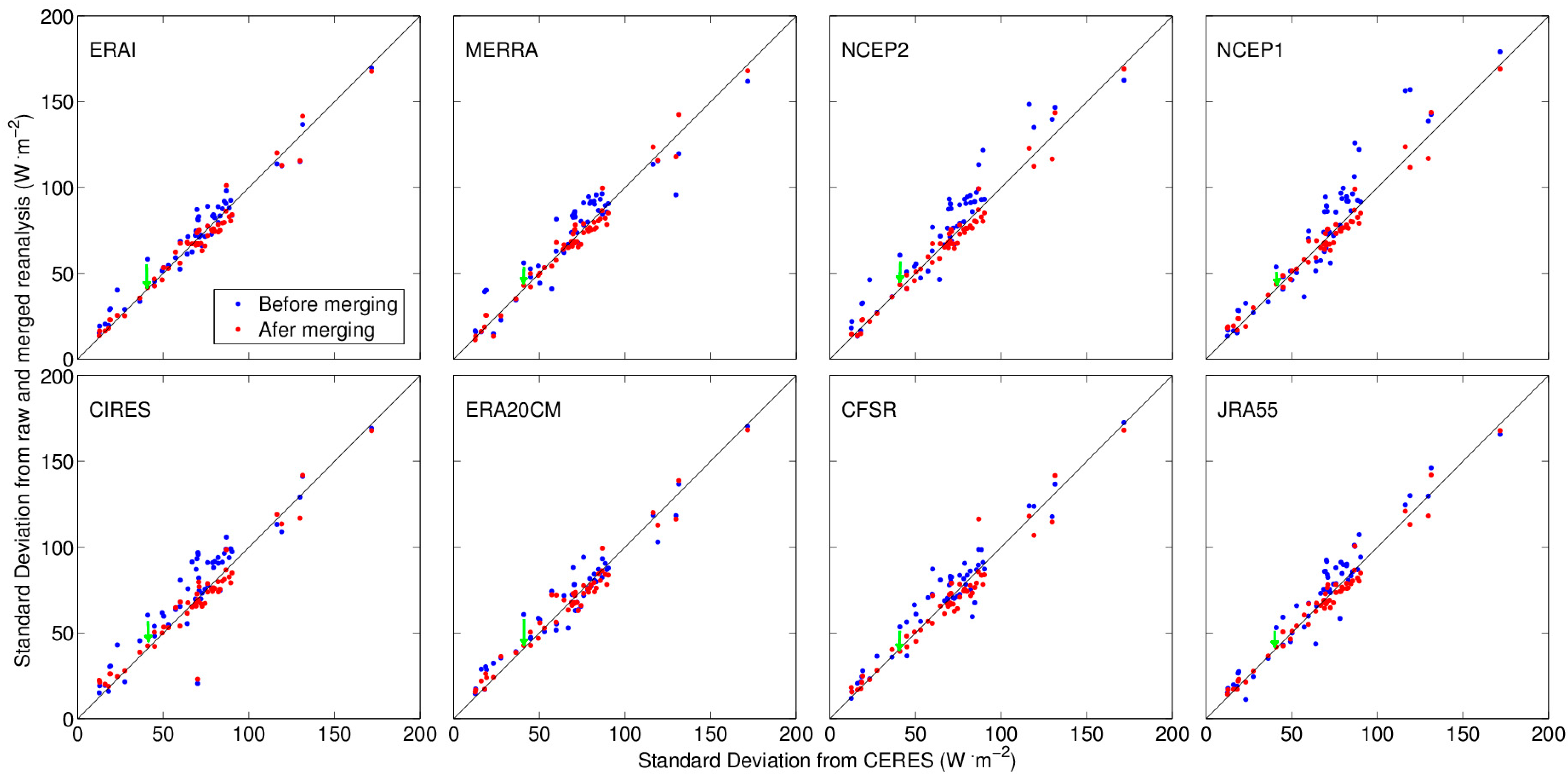
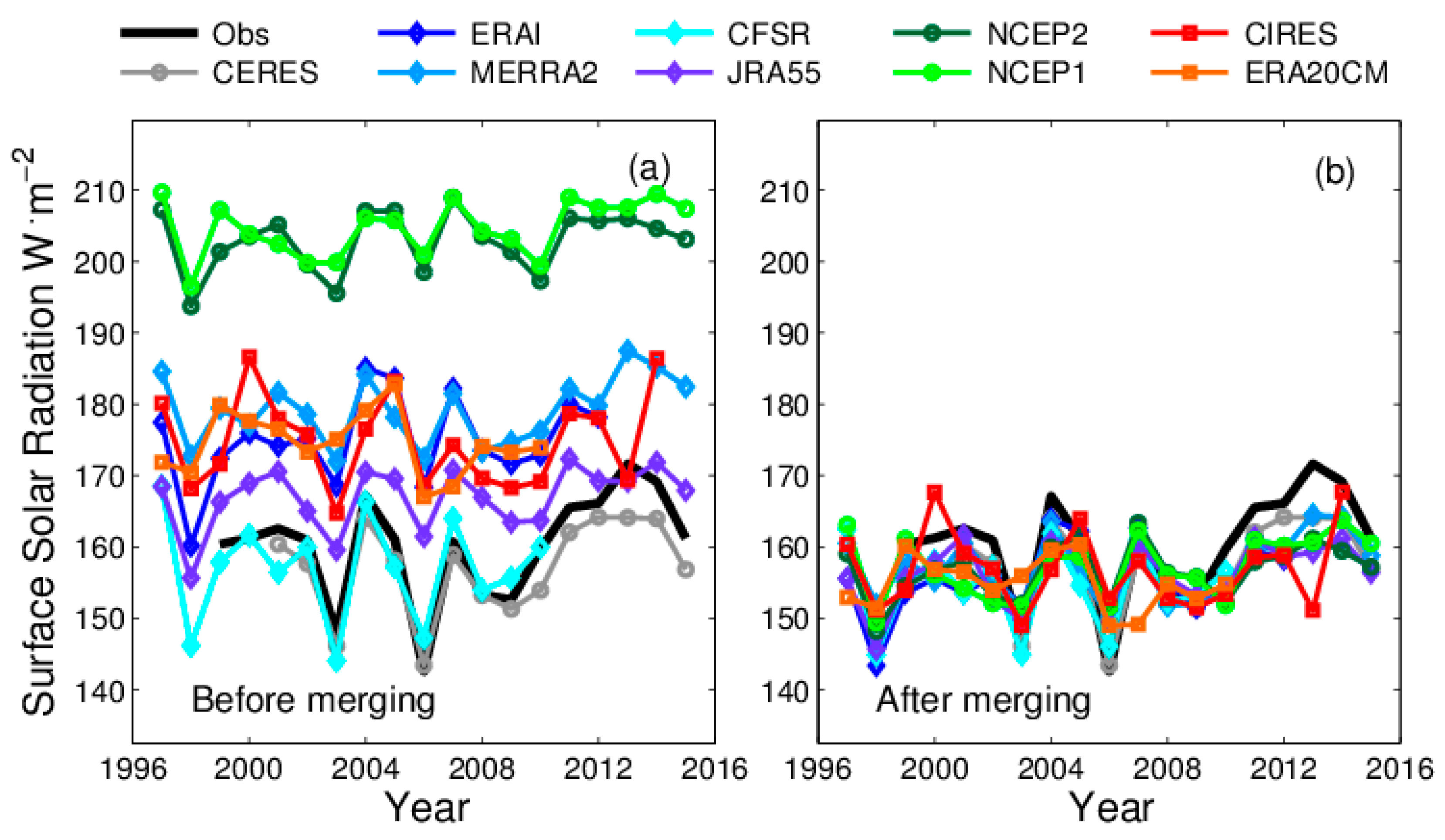
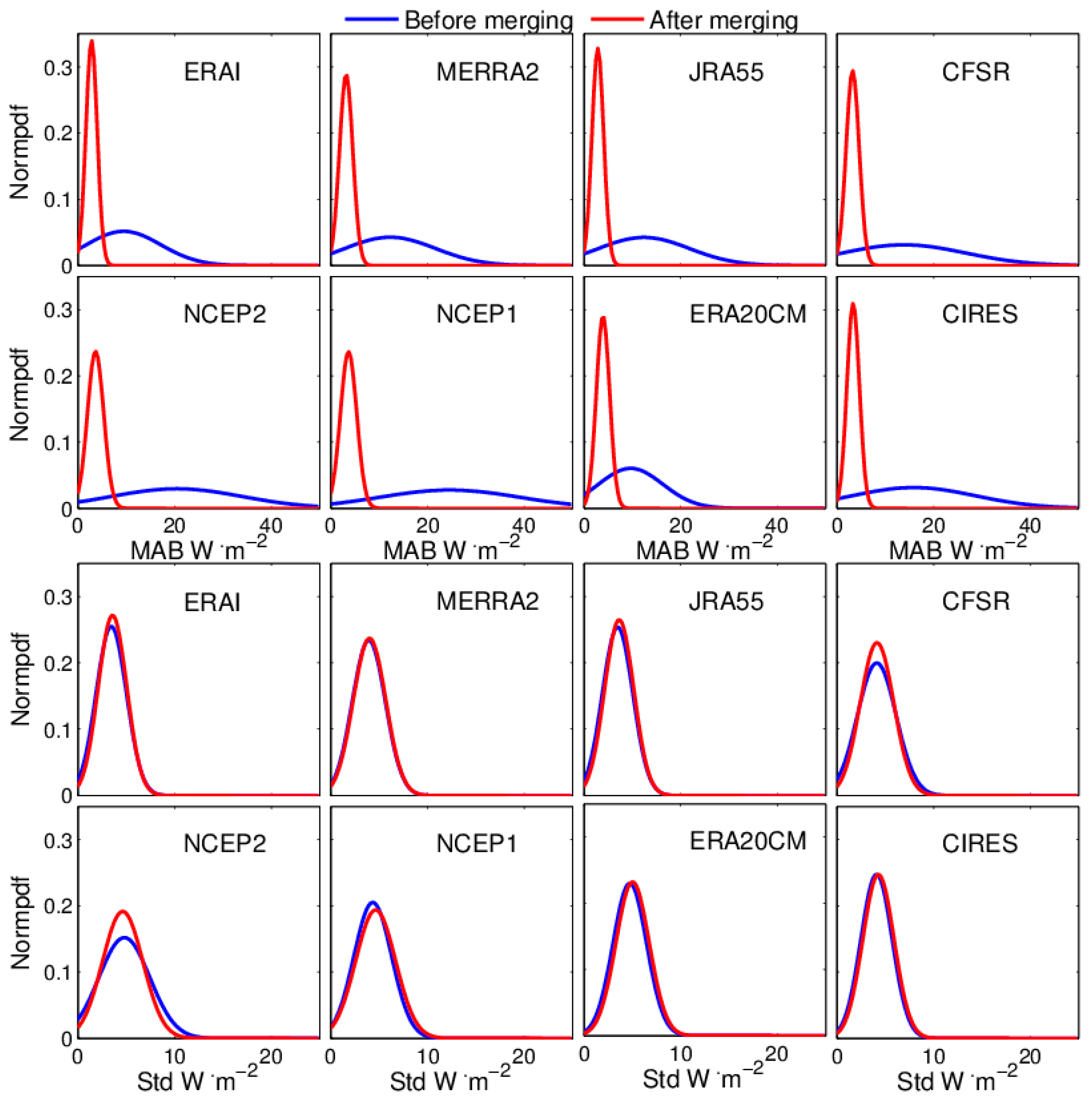
| Name | Spatial Resolution | Analysis Period | Cloud Overlap | Aerosols | Reference | MAB (W·m−2) |
|---|---|---|---|---|---|---|
| ERAI | 0.75° × 0.75° | 1979–2012 | Maximum-random | climatology | Dee et al. [43] | 12.62 |
| MERRA2 | 0.5° × 0.625° | 1980–2016 | Maximum-random | analyzed | Molod et al. [44] | 16.15 |
| CFSR | 0.3125° × 0.3125° | 1979–2010 | Maximum-random | climatology | Saha et al. [45] | 17.80 |
| JRA55 | 1.25° × 1.25° | 1958–2016 | Random | climatology | Kobayashi et al. [46] | 15.27 |
| NCEP2 | T62 1 | 1979–2016 | Random | - | Kanamitsu et al. [47] | 23.13 |
| NCEP1 | T62 1 | 1948–2016 | Random | - | Kalnay et al. [48] | 27.15 |
| ERA20CM | 1° × 1° | 1900–2010 | Maximum-random | climatology | Hersbach et al. [49] | 15.04 |
| CIRES | T62 1 | 1851–2014 | Maximum-random | climatology | Compo et al. [50] | 19.39 |
| CERES EBAF | BSRN | |||||||
|---|---|---|---|---|---|---|---|---|
| R2 | MAB | Bias | Std | R2 | MAB | Bias | Std | |
| ERAI | 0.97 | 13.16 | 7.89 | 16.21 | 0.97 | 13.20 | 6.96 | 16.79 |
| MERRA2 | 0.93 | 19.54 | 8.61 | 24.43 | 0.93 | 18.90 | 7.16 | 24.22 |
| NCEP2 | 0.88 | 28.14 | 16.68 | 31.28 | 0.89 | 26.89 | 16.36 | 29.97 |
| NCEP1 | 0.90 | 37.70 | 34.15 | 29.33 | 0.91 | 36.40 | 33.71 | 27.53 |
| CIRES | 0.94 | 19.03 | 12.33 | 23.24 | 0.94 | 19.12 | 12.10 | 23.83 |
| 20CM | 0.94 | 17.87 | 9.51 | 22.51 | 0.93 | 18.75 | 8.74 | 24.07 |
| CFSR | 0.93 | 18.16 | 7.14 | 25.51 | 0.92 | 18.74 | 5.76 | 27.04 |
| JRA55 | 0.94 | 16.92 | 8.18 | 21.56 | 0.95 | 16.64 | 7.62 | 21.43 |
| C-ERAI | 0.99 | 7.23 | −0.25 | 10.27 | 0.97 | 10.40 | −1.28 | 14.46 |
| C-MERRA2 1 | 0.98 | 8.43 | 0.15 | 12.54 | 0.97 | 11.59 | −0.45 | 16.48 |
| C-NCEP2 1 | 0.98 | 9.45 | −0.19 | 13.69 | 0.96 | 12.27 | −0.76 | 17.10 |
| C-NCEP1 1 | 0.97 | 10.28 | −0.16 | 14.84 | 0.96 | 12.97 | −0.86 | 18.25 |
| C-CIRES 1 | 0.97 | 10.07 | 0.14 | 14.32 | 0.96 | 12.99 | −0.82 | 18.15 |
| C-20CM 1 | 0.95 | 14.01 | −0.17 | 19.55 | 0.94 | 16.40 | −0.94 | 22.60 |
| C-CFSR 1 | 0.98 | 8.90 | −0.12 | 12.86 | 0.97 | 11.90 | −1.57 | 16.57 |
| C-JRA55 1 | 0.98 | 7.96 | −0.09 | 11.25 | 0.97 | 11.17 | −0.82 | 15.45 |
| Spring | Summer | Autumn | Winter | |
|---|---|---|---|---|
| ERAI | 3.60% | 3.03% | 3.07% | 3.87% |
| MERRA2 | 7.48% | 5.77% | 5.50% | 6.81% |
| CFSR | 4.68% | 3.92% | 4.75% | 4.48% |
| JRA55 | 4.52% | 3.41% | 3.41% | 4.14% |
| NCEP2 | 5.35% | 3.78% | 3.58% | 4.70% |
| NCEP1 | 7.88% | 5.79% | 5.67% | 6.76% |
| CIRES | 4.94% | 3.70% | 4.01% | 5.18% |
| ERA20CM | 3.95% | 3.90% | 4.10% | 4.82% |
| C-ERAI | 3.24% | 2.63% | 2.84% | 3.31% |
| C-MERRA2 | 5.58% | 3.95% | 3.80% | 5.76% |
| C-CFSR | 3.24% | 3.56% | 3.38% | 3.18% |
| C-JRA55 | 3.92% | 3.05% | 3.26% | 3.98% |
| C-NCEP2 | 4.39% | 3.40% | 3.08% | 4.16% |
| C-NCEP1 | 4.23% | 3.37% | 3.16% | 4.30% |
| C-CIRES | 4.28% | 3.18% | 3.39% | 4.46% |
| C-ERA20CM | 3.97% | 3.71% | 3.80% | 4.61% |
© 2018 by the authors. Licensee MDPI, Basel, Switzerland. This article is an open access article distributed under the terms and conditions of the Creative Commons Attribution (CC BY) license (http://creativecommons.org/licenses/by/4.0/).
Share and Cite
Feng, F.; Wang, K. Merging Satellite Retrievals and Reanalyses to Produce Global Long-Term and Consistent Surface Incident Solar Radiation Datasets. Remote Sens. 2018, 10, 115. https://doi.org/10.3390/rs10010115
Feng F, Wang K. Merging Satellite Retrievals and Reanalyses to Produce Global Long-Term and Consistent Surface Incident Solar Radiation Datasets. Remote Sensing. 2018; 10(1):115. https://doi.org/10.3390/rs10010115
Chicago/Turabian StyleFeng, Fei, and Kaicun Wang. 2018. "Merging Satellite Retrievals and Reanalyses to Produce Global Long-Term and Consistent Surface Incident Solar Radiation Datasets" Remote Sensing 10, no. 1: 115. https://doi.org/10.3390/rs10010115





